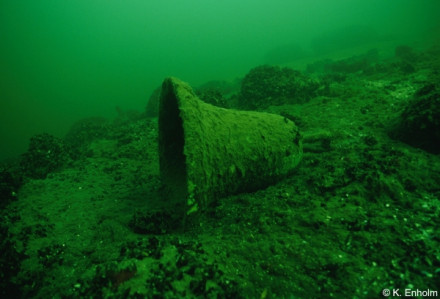History
Discovery of a possible cog in Finland
A marine biologists working near the island of Egelskär in Finland spotted a Romanesque church bell and pottery remains and concluded these must be the remains of a shipwreck. The site was initially mapped by a sports diver group called Rannikkosukeltajat ry in 1998, 2000, and 2001, followed by fieldwork carried out by the National Board of Antiquities of Finland led by Riikka Alvik in 2001 and 2003, and Stefan Wessman in 2005 and 2006. While the first campaigns were focussed on the cargo assemblage scattered across the seabed, the 2006 campaign focused on the structural remains of the wreck.
The wrecksite is scattered over a steep slope of bedrock at a depth of between 4-15 metres in depth. Much of the cargo has been discovered at a distance from the structural remains of the wreck, so the loss of the ship has been interpreted as full capsize.

As a dendrochronological analysis has not been carried out, the interpretation of the wreck's presumed origin and route focused mainly on the cargo, especially the ceramics. In her Master's thesis, Riikka Tevali re-examined the entire ceramic assemblage lifted from the wrecksite between 1996 and 2007 and was able to associate the stoneware with the Fredelsloh-Bengerode production centre in Lower Saxony, with a production date between 1250 and 1270.
Based on the cargo assemblage, which included also whetstone schists most probably from Norway, limestone ballast, bronze cauldrons and Osmund iron, a hypothesis on the sailing route was presented in Daniel Zwick's doctoral thesis, who suggested Rostock as port of transshipment and departure, and Tallinn as likely destination. This puts the ship and the route firmly into the Hanseatic trade network.
Description
Although the constructional characteristics of the shipwreck itself have not been studied in depth due to the nature of the site, it was confirmed by Stefan Wessman that some of the observed characteristics point to a type of construction related to the Bremen cog, also referred to as the 'bottom-based' type, which is commonly associated with the cog' ship type.
Status
The site is protected in situ by Finnish law, and the National Board of Antiquities of Finland cooperates with sport diver groups who carry out site monitorings. Nontheless, the first campaigns concentrated on lifting all visible artefacts for fears of looting.
References
- Alvik, R. & Haggrén, G. (2003).
Keskiaikainen haaksirikkopaikka Nauvon ulkosaaristossa.
Suomen keskiajan arkeologian seura (SKAS) 2, 2003.
pp 18-27. - Tevali, R. (2010).
Fancy jugs for everyone! Stoneware from the Egelskär wreck 1996-2007 (=unpublished Master's Thesis).
Helsinki. - Wessman, S. (2007).
Ship Fragments on the Seafloor – What Do We Know about Medieval Seafaring in Finland?.
pp 140-150.
Turku. - Zwick, D. (2017).
Maritime Logistics in the Age of the Northern Crusades (=doctoral thesis).
University of Kiel.